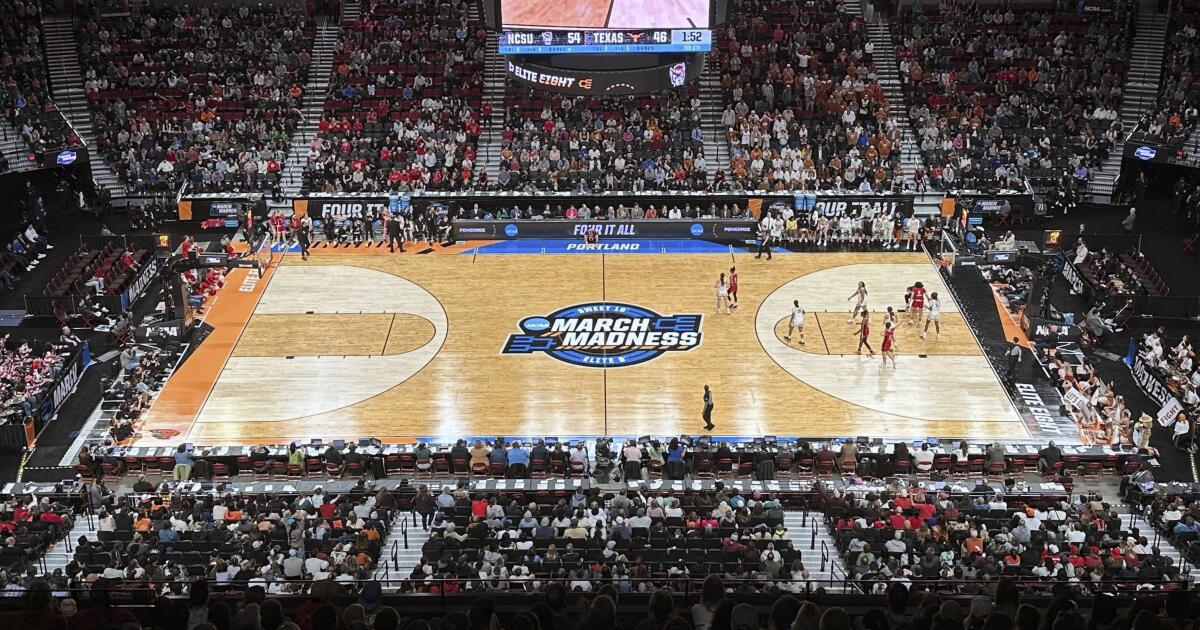Makes sense, right? Most people probably assume that’s the case for every game.
But it was not the case during USC’s and Connecticut’s NCAA women’s basketball tournament Sweet 16 games Saturday at the same court. Nor was it the case during the other three tournament games played this weekend, including North Carolina State’s 76-66 win over Texas on Sunday to advance to the Final Four.
Instead, one three-point line appeared to be several inches closer to the basket than the other.
The NCAA said in a statement Sunday that it had been notified of the situation prior to the N.C. State-Texas game.
“The NCAA staff and Women’s Basketball Committee members on site consulted with the two head coaches who were made aware of the discrepancy,” NCAA vice president of women’s basketball Lynn Holzman wrote. “All parties elected to play a complete game on the court as is, rather than correcting the court and delaying the game.”
Holzman said the NCAA would measure all court lines and markings following USC and Connecticut’s practices Sunday night and make any necessary corrections prior to Monday’s game, which will determine which of the two teams will face the Iowa-Louisiana winner in the national semifinals Friday in Cleveland.
Connor Sports, the vendor who made the floors for the NCAA men’s and women’s tournaments, issued an apology for the error Sunday. Holzman said in her statement that the NCAA is not aware of any such issues at other tournament venues and will investigate what went wrong with the Moda Center court.
“The NCAA regrets the error was not discovered sooner,” Holzman added.
The three-point line for NCAA men’s and women’s games is at 22 feet, 1 3/4 inches. The NCAA did not provide details on the discrepancy in Portland, but the Associated Press reported that one arc was at the correct distance while the other (which is to the left of a right-side-up March Madness logo at center court) appeared to be about 6 inches closer.
In the four Sweet 16 and one Elite Eight games played in Portland this weekend, the teams attempting threes on the correctly marked end made 29 of 87 shots (33.3%), compared with 23 of 89 (25.8%) on the closer end. Both teams in each game spent one half shooting at each end.
“Guess that’s why we shot it better in the 2nd half… correct 3 pt distance!!” Baylor coach Nicki Collen tweeted Sunday, a day after her team’s 74-70 loss to USC in a Portland 3 regional semifinal. The Bears made three of 12 three-point attempts in the first half, compared to six of 14 in the second half.
Guess that’s why we shot it better in the 2nd half… correct 3 pt distance!! FYI with 8 teams at one site you get so little prep time on the main court and your focus is on game planning and simply getting shots up!
— Nicki Collen (@NickiCollen) March 31, 2024
For the season, USC has made 35.6% of its three-point shots, while Connecticut has made 36.3%. Both teams shot below those averages in their Sweet 16 games. The Trojans were 29.4% from three-point range against Baylor, making two of seven attempts in the first half and three of 10 in the second. Connecticut fared even worse from behind the arc during their 53-45 win over Duke, going 0 for 5 from the shorter end in the first half and 3 for 12 at regular distance in the second half.
Following the N.C. State-Texas game, both coaches were asked about the decision to play on the mismarked court.
“I was worried about if our players were going to have to wait an hour to play,” N.C. State coach Wes Moore said. “I like the fact we could jump out there and play the game. And, again, I don’t think it affected the game, the outcome. Both teams played on it for a half.
“If it would have gone to overtime, we might have a complaint. But as it was, it was equal for both teams.”
Texas coach Vic Schaefer said: “At the end of the day, we had already played a game on it. We both won. So we just decided to play.”
